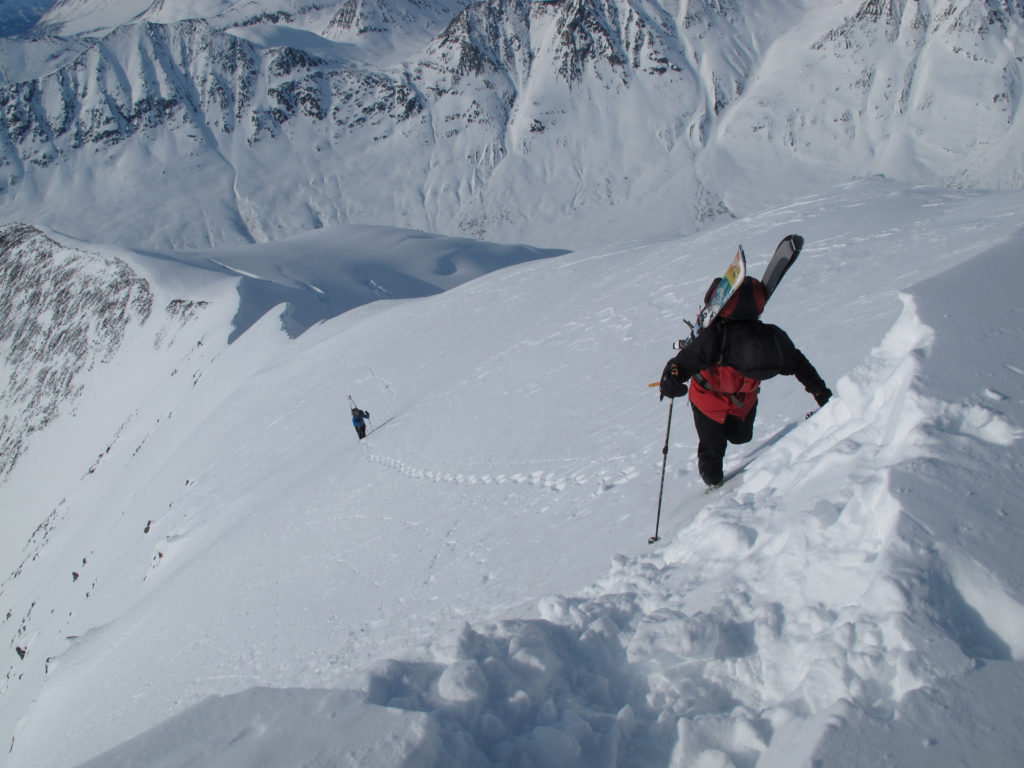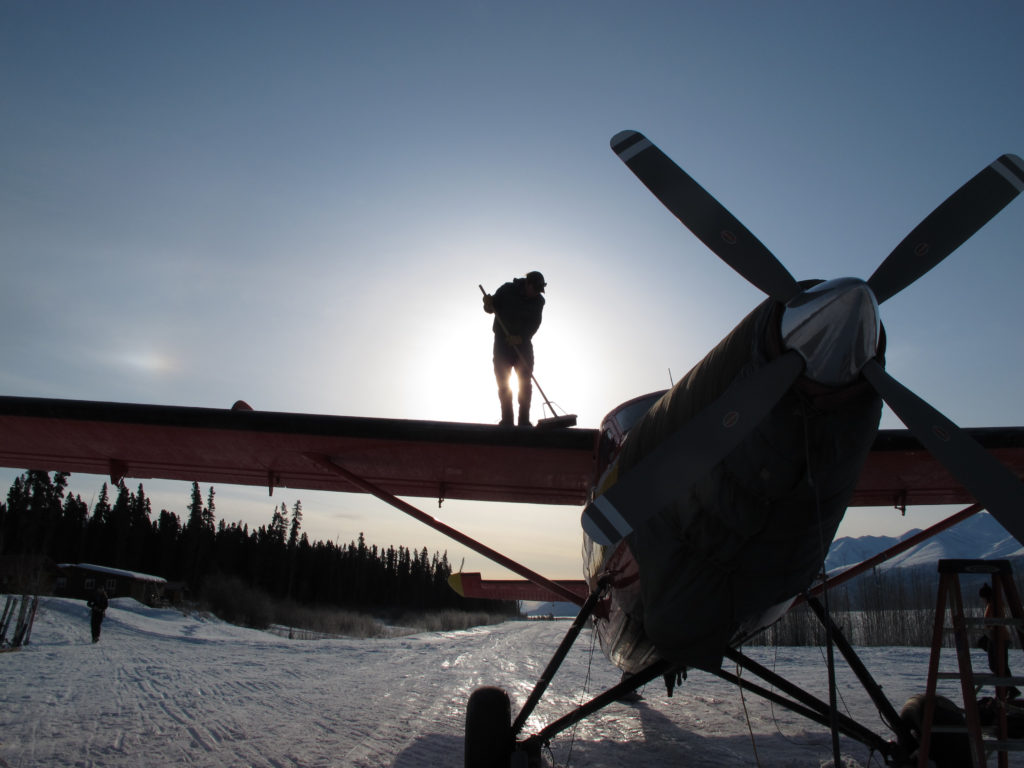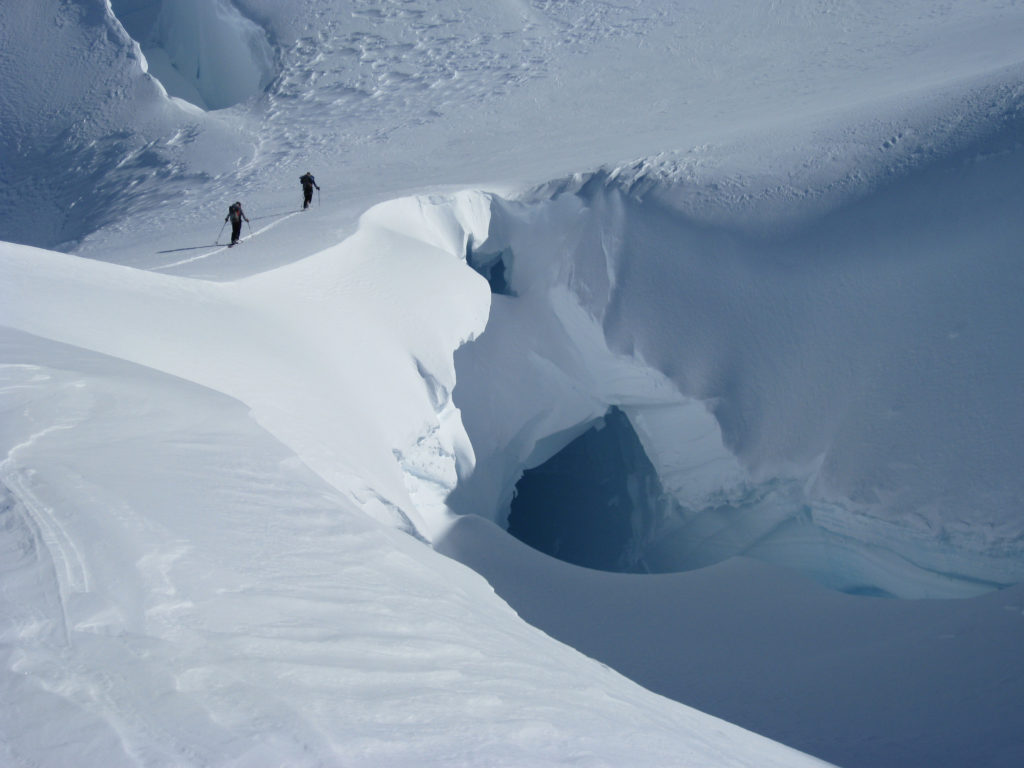Photos by Andrew McLean
Before my first trip to the Ultima Thule Lodge I knew there was a risk of addiction, but thought I’d be immune to it. The warning had come from a Swiss friend, Ruedi Homberger, aka Hombi, who is one of the most travelled skiers I’ve ever met with over 20 trips to the Himalayas alone. Hombi had skied all over the world, but when I first met him, he had forsaken all other locations for the Ultima Thule Lodge, and not only that, but he was spending weeks, or even months up there. Always on the lookout for new ski mountaineering adventures, I had to ask – “So Hombi, what’s the deal with this place?” Responding in his thick German accent, all he could say was “Oh Andrew… you just have to go see it for yourself to believe it.”
That was in 2006, and since then I’ve been up there seven times and hope to log another 30 or 40 before I die. What Hombi didn’t mention is that this area, the Wrangell-St.Elias National Park & Preserve (WSNPP) is the Holy Grail of ski mountaineering on earth. After skiing here, everything else seems crowded, small or cute. It has the vast expanses found in Antarctica, but unlike the frozen desert continent, it has deep, gorgeous powder as well, and lots of it. The longest skiable run in the world, the 18,000’ southeast side of Mt. Saint Elias is here, but that is just one of millions of skiable peaks in the park, which is why it is known as The Mountain Kingdom.
At 13.2 million acres, WSNPP is larger than another well-known ski destination: Switzerland. If that isn’t enough for you, when combined with equally sized Canadian Kluane National Park next door, it is 25 million acres, or the size of Nepal. With numbers like these, you might wonder what the Gross Domestic Product is, but with no roads, cities or urban population, there is nothing to count but ski runs, turns and smiles. The downside of an area this large without roads is that it is very difficult to do more than nibble around the edges if you are on foot as the terrain is so rugged and endless, which is why bush planes play such an important role in visiting the heart of the park.
The park was created in 1980 under the Carter administration and is the largest national park in the United States by a long shot. Prior to creating the park, there were quite a few private inholdings of land in the area, including the Kennecott Mine which is located near the town of McCarthy and later established an operation in Utah where it is known as the world’s largest open pit copper mine. When first discovered in the early 1900’s, the Alaskan mine was the richest concentration of copper in the world, and was only later abandoned in 1938 due to the advent of open pit mining verses hard rock digging.
Another private inholding took place in 1960 when John Claus staked a 5 acre lot on the Chitina River as part of the Alaska Homestead Act. But staking a lot and actually making something of it are two very different endeavors. Being 100 miles from the nearest road, the Claus family created a runway and began flying in everything they would need to eventually create what is now known as the Ultima Thule Lodge. The lodge itself was almost consumed by the wandering river and after being moved, it burned down and had to be rebuilt. In the end, after the area was turned into a National Park and the lodge was grandfathered in, it became a five acre lot with a 13 million acre backyard, which is how it remains to this day. The name itself comes from ancient Greek and refers to unknown lands beyond the northern extent of their maps.
In the 54 years since it was first platted, the Ultima Thule Lodge has been the home of three generations of the Claus family. Paul and Donna, the second generation, were not only skiing, climbing, hiking and hunting enthusiasts, but by necessity, Paul became an excellent bush pilot as well. This combination of skiing and flying is what make Paul, his son Jay and son-in-law Ben, such valuable players in the Wrangell-St. Elias area – they know what skiers like, know where to find it, and know the best way and time to get you there. When you book a trip with Ultima Thule, their background knowledge is invaluable.

Dr. Paul Lambie about to top out on Solidarity Peak in the St. Elias Mountains. The descent clocked in at 6,000′
After a few mishaps, including the burned lodge and dark, cold isolation, Ultima Thule now closes down for the winter and then starts up again in late March. The landing strip at that time is on snow, so the planes are either outfitted with skis or wheel skis. One of the first organized programs of the season is the Wilderness Ski Week, where the entire lodge is reserved for a group of 12 skiers, which consists of three guides and nine clients. This is one of the few organized annual offerings and for the rest of the ski season (April through mid May), the lodge offers customized packages for smaller groups of people which generally run either a standard four nights/four days of skiing, or a custom package from 3-7 nights.
The trip out to the lodge begins with a commercial flight into Anchorage and then a six hour drive out to the small town of Chitina where there is a dirt landing strip, or driving another 60 miles to the town of McCarthy, which also has a strip. Once there, a plane from the Ultima Thule picks you up and flies you into the lodge which has a variety of cabin arrangements, saunas, and provides all of the cooking. From here, the skiing takes place with a plane ride out to any number of skiing zones where you spend the day touring before being picked up at the end of the day and flown back to the lodge. While aircraft are allowed in the park, heli-skiing is not, so earning your turns is the only way to go.
One of the secrets to successful skiing at the Ultima Thule Lodge is Paul’s nonbiological fourth child: the Turbine Otter. I can barely tell the difference between a Cessna plane or a sesame bun, but after flying in the Turbine Otter a few times, I became an instant Otter fanatic. Originally starting life as a rotary piston engine aircraft, which was described as “ground loving,” Otters are enjoying a popularity resurgence after being retrofitted with 1,000 horsepower turbine engines. The Ultima Thule Otter was one of the first to undergo this modification and Paul has many, many hours behind the controls. The advantage of the Turbine Otter is that it can easily hold ten people plus gear, and with a reversible propeller to give it braking power, it can easily land in very tight mountainous spots. Plus, it is fast.
At 100+ mph, a twenty minute flight from the lodge opens up vast amounts of terrain. Depending on the weather and conditions, you can fly to any number of different elevations or aspects to find the best skiing. It would be like taking off and having your choice of the Wasatch, Sawtooths or Tetons on any given day. The lodge itself is at a fairly low elevation of about 1,200’ above sea level and is also located on the Chitina River, which often forms a crossroads for weather. If it is stormy in one direction, there are plenty of other places which are not. If a warm spell comes in, it is easy to go higher to find colder snow. The Otter often works in conjunction with smaller airplanes, which gives the pilots a chance to ski as well as helping out with logistics.
A typical day of skiing with Ultima Thule during Wilderness Ski Week involves waking up at about 7:00am, a breakfast made by Donna Claus by 8:00, some organizing time and then loading the plane around 9:00 or 10:00. This may seem like a leisurely start, but it gives the planes a chance to warm up after a cold Alaska night, plus, the days are getting longer and longer that time of year, so it is possible to ski until 5:00 or 6:00pm before getting picked up.

Eli Potter, co-owner of Wild Alpine guiding service, lays waste to a perfect pitch. St. Elias Mountains
Depending on the conditions, the plane will usually land in a high col or on the shoulder of a peak. From here we’ll ski around in the upper Alpine area above the trees and get in a warm up lap or two. Each day has a different agenda with offering like a peak day, a couloir day, powder days, a multi valley tour, big classics or something else. The horizontal distances are often much longer than in places like the Wasatch, so we get a moderate amount of vertical climbing in, averaging around 4,500’ a day, but over many miles. At the end of the day we will often get an extended run all the way down to the valley floor where an armada of planes is waiting for us. From here it is a flight back to the lodge where preheated saunas await, a dinner made from local ingredients such as sheep or moose and then get ready to do it again tomorrow.
As good as the skiing is, it is often eclipsed by the plane flight back, especially if you get a chance to ride in one of the smaller Super Cubs. This is mountain flying at its best and seeing how tiny your ski tracks look from above gives you sense of how huge the surrounding environment really is. Unlike commercial flights which take the most direct line between point A and B, mountain flying involves working with the terrain to gain altitude, flying through passes, seeing wildlife such as bears or wolverine and the mountainscape and weather to provide the smoothest, safest flight possible. When you throw in melted legs and warm afternoon alpenglow lighting, it just doesn’t get any better. The pilots do not disappoint.
A few years ago, after yet another incredible run, it occurred to me that the majority of the top runs of my lifetime took place in the Wrangell-St.Elias National Park & Preserve. There were other greatest hits here and there like Baffin Island, Mt. Hunter, Lisa Falls and others, but no one place has such a high concentration of classics. I don’t know if these runs even have a name on a map – they were just there. A typical monster run starts with summiting a peak and skiing a headwall which may turn into a couloir, which turns into an apron, which turns into a deep valley which gets tighter and tighter until it spills out onto a braided river bed many thousands of feet below. In one case, Tyler Reid and I were running late and decided to nonstop such a line, which ended up being a 28 minute solid powder run and we didn’t even start from the top.
Aside from day trips out of the lodge, there is no shortage of expedition projects where you can get dropped off and do your own cooking and camping before getting picked up a week or so later. Some of these are classic lines like the South Face of University Peak or Saint Elias, but there are also objectives like kiting on the Bagley Icefield or setting up camp in a concentrated skiing area and make day trips from there. There are skiable lines on many of the Wrangell Mountain classics like Mt. Bona, Drum, Blackburn and Sanford, as well as having the highest peak in Canada, Mt. Logan, right in the neighborhood as well. It is an overwhelming amount of possibilities and talking to Paul Claus or some other pilots at the lodge is a good place to start. Some of the peaks have good skiing, but tough landing conditions, which is something only the pilots will know about.
The WSENPP is so large that it entails four separate mountain ranges; the Wrangells, the western segment of the Saint Elias Mountains, the eastern part of the Chugach and the Nutzotin Mountains. Each of these has its own characteristics and storm patterns. The Wrangells have ten separate volcanic peaks which top out at 16,360 feet (Blackburn) as well as all-you-can-eat crevasses. For skiers, the legendary Chugach needs no introduction. The Saint Elias Mountains are closest to the coast and are incredibly rugged, prone to furious storms and don’t give up their secrets easily.
Skiing in the WSENPP is an acquired taste and takes some getting used to. There is no local avalanche forecasting, the terrain is as big as it gets and the closest rescue party may be 60 miles away, if they can even get to you. Because of this, skiing takes on a much more serious tone and requires a much greater degree of respect than ducking under a rope in the Wasatch – not that this doesn’t have its own dangers. Charging big, steep, deep lines in places like Valdez is one thing, but in 13.2 million acres of wilderness, caution is the better part of valor. The attraction in the Wrangells has more to do with making turns in an amazing place, rather than just making amazing turns.
This overwhelming sense of location was emphasized on a run we took in 2013. After landing on a frozen lake in the shadow of Mt. Blackburn, three of us skinned uphill for a “quick run,” which ended up being three hours and 4,000’ to reach the summit of a nice, nondescript peak. As I was skinning along the final ridgeline, I noticed an old set of tracks heading towards the summit and wondered who else had been lucky enough to have recently skied up here. In a few more steps, it became apparent that the skin tracks were actually just parallel wind features as they drifted off a thousand foot wall to my left. On reaching the summit, we had a front row seat to Blackburn’s 11,000’ of vertical relief, the Chitina River Valley below and an epic run separating us from the tiny little red dot of a plane which waited for us far below.
When we finally returned to the plane, I asked Paul what the name of this place was. “Here? I think it is called frozen lake near the south face of Blackburn. It looked like a good landing spot.” As the plane climbed up, we first lost sight of our tracks, then soon enough our perfect little peak was lost in a jumble of hundreds of others. As good as the skiing was, the turns were dwarfed by the landscape and brought back Ruedi Homberger’s words – you just have to go to believe it.
References:
www.wildalpine.com – Wilderness Ski Week
Books
My Wrangell Mountains by Ruedi Homberger and Jon & Jona Van Zyle
Mountain Wilderness – An Illustrated History of Wrangell – St. Elias National Park & Preserve by William R. Hunt














